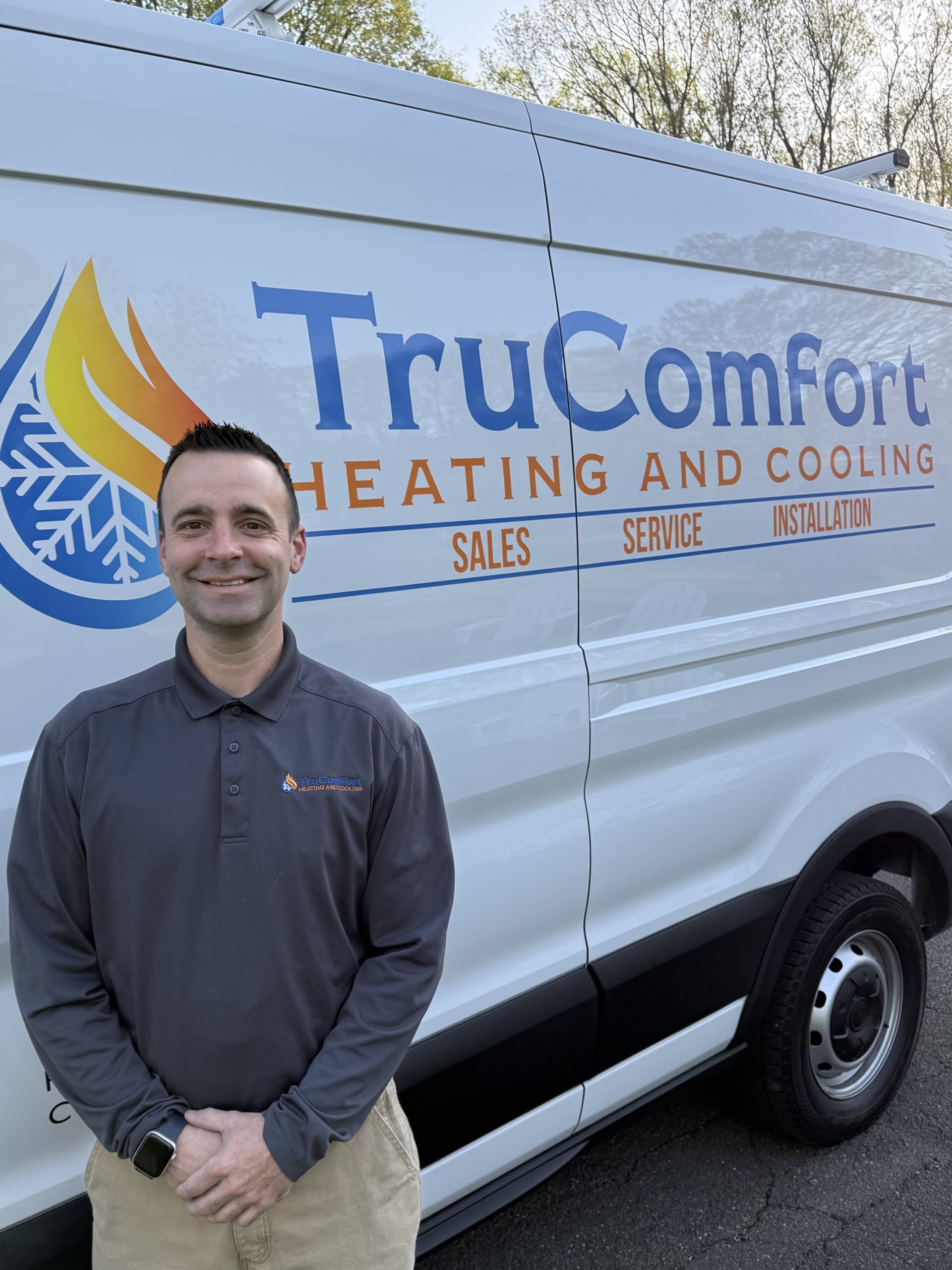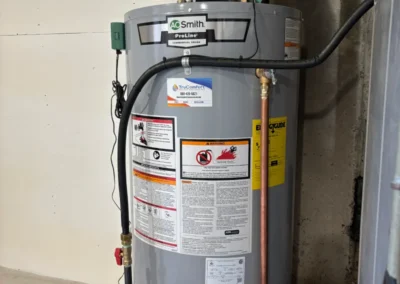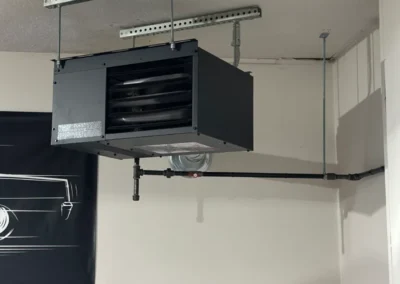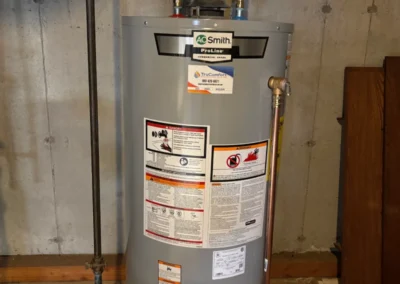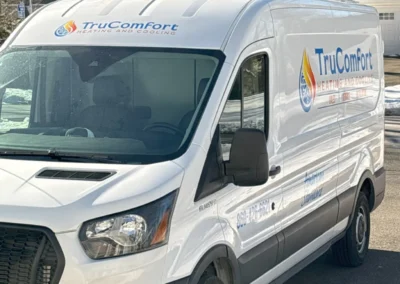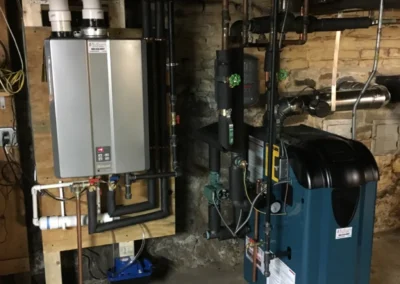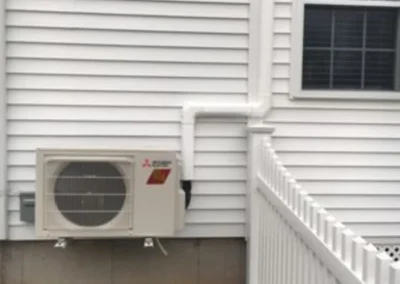Comfort You Can Count On
TruComfort Heating and Cooling Of Southington, CT
Proudly serving Southington, Cheshire, Plainville, Bristol, Avon, Farmington, West Hartford, and beyond, TruComfort Heating and Cooling delivers expert heating and cooling solutions with reliability and care. Whether you need installation, repairs, or maintenance, our team ensures your home stays comfortable year-round. Trust us for quality service, honest pricing, and exceptional workmanship in your community!
About TruComfort Heating and Cooling
At TruComfort Heating and Cooling, we’re more than just a heating and cooling company—we’re a local, family-owned business committed to keeping our community comfortable. With over 20 years of experience in the HVAC industry, we take pride in delivering personalized service, honest advice, and quality workmanship to every customer.
Learn More
As a family-run business, we understand the importance of maintaining a comfortable home throughout the year. Whether you need routine maintenance, emergency repairs, or a system upgrade, our certified technicians treat every home as if it were their own—with care, respect, and attention to detail.
Our dedication to customer satisfaction and community values sets us apart. When you choose TruComfort Heating and Cooling, you’re not just a client—you’re part of the family. Let us be your trusted partner for all your heating, cooling, and water heater needs, helping you stay comfortable in every season.
Our heating and Cooling Services
At
TruComfort Heating & Cooling, we provide expert
heating installation, repair, and
maintenance
as well as
cooling system services
in Southington, CT. Our team works on all major
HVAC systems, delivering reliable comfort,
better energy efficiency, and long-lasting
performance to keep your home running at its
best year-round.
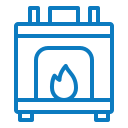
Heating Services
Stay warm with our high-efficiency furnaces, heat pumps, and boilers. From installation to seasonal tune-ups and emergency repairs, we keep your system running smoothly.

Air Conditioning Services
Beat the heat with our reliable AC solutions. We offer professional installations, fast repairs, and energy-efficient upgrades to maximize cooling comfort.
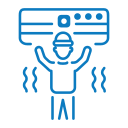
Indoor Air Quality Services
Breathe cleaner air with our purification systems, humidity control, and ventilation improvements. Our solutions enhance indoor air quality for a healthier home.

Ductless Systems
Enjoy flexible comfort with high-efficiency ductless systems. Perfect for any space, these energy-saving solutions provide customizable temperature control.
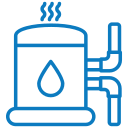
Water Heaters
Ensure a steady hot water supply with our expert water heater services. We install and replace gas, electric, tankless, and hybrid systems with same-day availability
Heater Not Working
Table of Contents
Why Furnaces Suddenly Stop
Scope Of This Guide
This guide exists for Connecticut homeowners and property managers intent on confronting a failing heating system with facts, not panic. It is engineered for residential situations, where the boundary between safe troubleshooting and risky intervention is sharply drawn. Only procedures proven safe for nonprofessionals enter these pages. Commercial or multifamily systems fall outside this scope, as do risky DIY repairs that violate local code or warranty terms. Homeowners using this resource will find precise steps for basic troubleshooting, clarity on when to step back, and direct guidance on securing help from a certified professional. Community safety, not experimentation, drives every recommendation in this guide.
Quick Problem Overview
The vast majority of non-working home heaters fail for mundane, fixable reasons. Power supply faults, thermostat confusion, airflow blockages, and ignition problems account for over 80% of emergency calls according to industry data. Each can present subtly or as dramatic system silence. A failure to ignite or heat does not mean catastrophic breakdown. Yet some signals--such as gas smell or sparking--demand immediate disengagement for safety. Most systems include built-in safety cutoffs. Recognize their value: these shut your furnace down long before a minor fault can become a hazard.
What You Will Learn
This guide delivers actionable steps to restore heat, spot the difference between a fixable inconvenience and a looming emergency, and choose when to halt and call a licensed technician. You will learn to isolate faults using a logical process, check for Furnace Stopped Working warnings, and respond to risky signs with zero hesitation. By the end, you will see how preventive maintenance plans eradicate 70% of common failures and extend equipment life--proven fact, not marketing spin.
Heating System Fundamentals
How Furnaces Work
Every residential heating system, whether gas or electric, follows a clear pattern. Gas furnaces burn natural gas to produce heat via combustion, transferring warmth into air circulated by a blower. Electric furnaces pass current through resistance coils, producing heat without any flame or combustion. The airflow path remains identical: intake air filtered and rerouted across the heat exchanger or coils before circulating into rooms. Heat pumps operate on an entirely different principle, extracting thermal energy from outdoors--even below freezing--compressing and releasing it indoors. Most failures share common roots: power interruption, airflow restriction, or ignition malfunction. The method changes, but the breakdown symptoms--no heat, odd noises, or cold air--persist across all system types. Homeowners who master these basics are immediately better positioned to diagnose what standard service contracts often miss.
Common Components
Residential furnaces are not mysterious. The key elements are instantly identifiable: thermostat, air filter, blower motor, ignition system or pilot (for gas), gas valve, and safety switches. Ignite failures can arise from defective igniters, malfunctioning pilot lights, or misfiring flame sensors. Blocked or dirty filters cripple airflow, causing limit switches to trip and shut the system down. Thermostats--the brains of the operation--are responsible for countless false alarms, as a single incorrect setting or dead battery mimics system failure. Safety switches protect life and property, instantly disabling heating when an unsafe condition (like a loose panel or overheated exchanger) is detected. Understanding these points is not optional for responsible homeowners.
Safety Risks Overview
Carbon monoxide, electrical faults, and fire rank as the greatest threats in the heater failure landscape. CO leaks kill thousands annually and are undetectable without sensors. Smoking or sparking furnaces are cause for immediate evacuation--not inspection. Never override a safety device. If you suspect carbon monoxide or gas odor, exit at once and seek professional help. No DIY project justifies the risks; responsible service demands the involvement of credentialed experts.
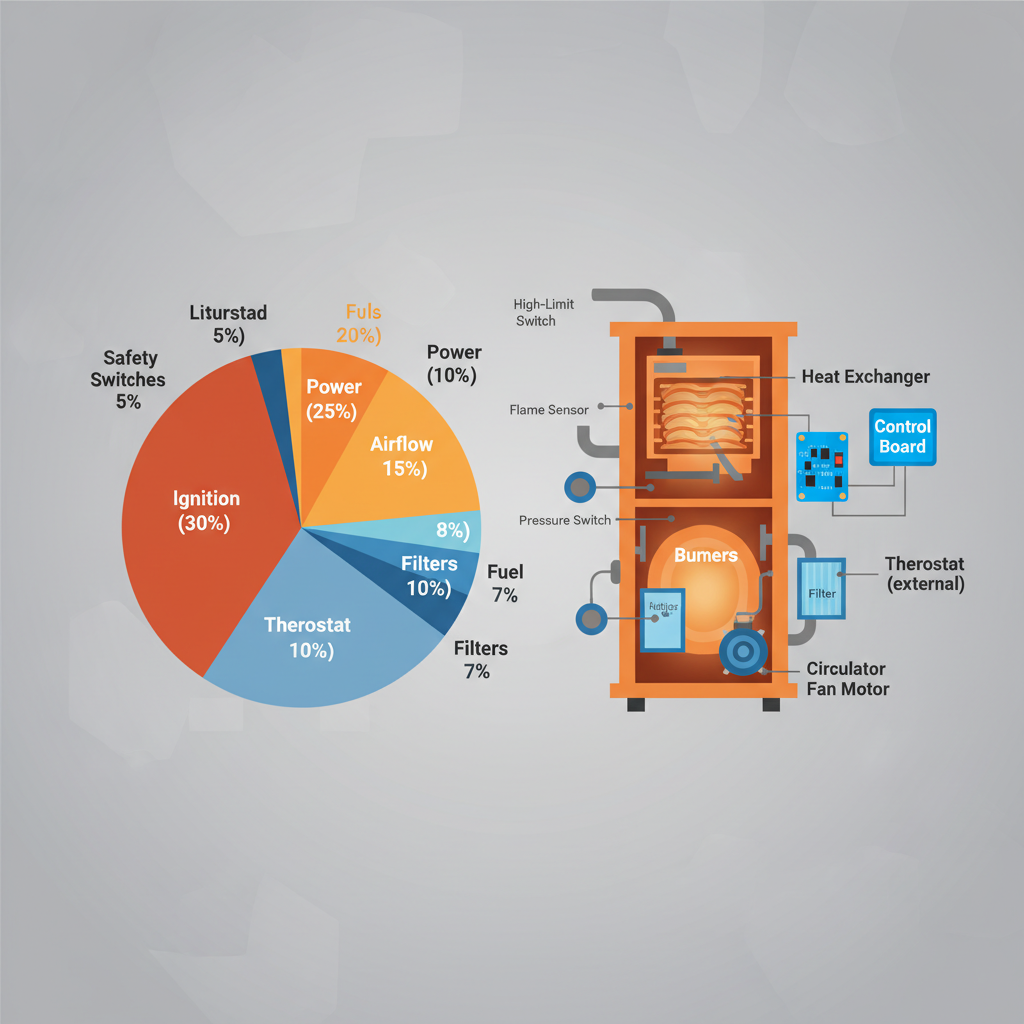
Common heating system failures and furnace component overview.
Common Failure Causes
Why Heaters Fail
No heater fails by accident. The very top causes for residential systems are clear: thermostat misconfiguration, power disruption, clogged filters, ignition faults, gas supply interruptions, airflow obstructions, and safety switch interventions. Dirty air filters alone create over half of "no heat" service calls--clogged filters force a shutdown by tripping limit switches. Power issues dominate the rest: tripped breakers, loose panel switches, or dead thermostat batteries. Gas units add extra complexity: pilot failures, faulty igniters, and gas valve troubles have all been repeatedly documented by Furnace Stopped Working complaints. Short cycling, where the furnace turns on/off rapidly, points directly to bad thermostat placement or severe airflow restriction. No mystery here--just a system protecting itself until a real solution appears.
Troubleshooting Logic
Methodical troubleshooting separates amateurs from experts. Step one: always verify the thermostat is actually calling for heat and set above the current room temperature. Step two: Confirm system power--both at your panel and the unit itself. Step three: Inspect and replace air filters without delay. Step four: Listen and observe. Whistling, clicking, or abnormal silence provide direct diagnostic clues. If the system uses gas, visually confirm pilot status or check electronic ignition indicators. Lockout codes or repeated restarts indicate a persistent safety problem--these demand professional intervention. No step requires guesswork. Each is supported by service records at TruComfort and nationwide industry data.
Safety System Triggers
Limit switches, flame sensors, and pressure sensors exist exclusively to keep you alive. Limit switches shut off the furnace when overheating is detected--almost always a symptom of poor airflow. Flame sensors prevent dangerous gas accumulation by demanding proof that burners ignite properly. Pressure switches confirm exhaust venting before operation. If these systems halt your furnace, their intervention is never optional. Repeated lockouts, such as flashing lights or panel alerts, require expert analysis. Bypassing safety trip mechanisms directly voids warranties and jeopardizes insurance, property, and, bluntly, lives.
Failure Cause Comparison Table
Symptom Likely Causes Homeowner Check Need Pro?| No Power | Tripped breaker, switch off, thermostat batteries | Check breaker, furnace switch, thermostat power | Usually no unless wiring issue |
| Blows Cold Air | Thermostat, pilot/ignition, gas supply, heat exchanger | Verify thermostat, check pilot/ignition lights | Often yes for gas or flame issues |
| Short Cycling | Oversized unit, bad thermostat location, airflow | Check filters, vents, thermostat location | Yes for diagnosis |
Homeowner Troubleshooting Guide
Troubleshooting Checklist
The most effective troubleshooting process for any residential heater follows six evidence-based steps:
- Check Thermostat: Confirm it is set to heat, above room temp, and that batteries are live.
- Verify Power: Inspect the panel breaker, furnace switch, and ensure the door is fully closed (panel switches disable units for safety).
- Inspect Filter: Remove and check air filter for dust; replace if dirty, as clogged filters cause the majority of heat failures.
- Check Ignition: For gas, look for the pilot light or ignition indicator. Electric systems: ensure power and listen for click or hum.
- Safety Warnings: If you smell gas, observe sparks, or detect burning odors, stop immediately. Evacuate and call for professional help.
- Call Professional: If all checks fail, or you see warning codes, do not reset repeatedly--technician intervention is now required.
Never attempt ignition repairs or bypasses yourself. TruComfort's Comfort Care Maintenance Plans were built precisely to avoid these escalation scenarios, offering priority response and issue prevention for members.
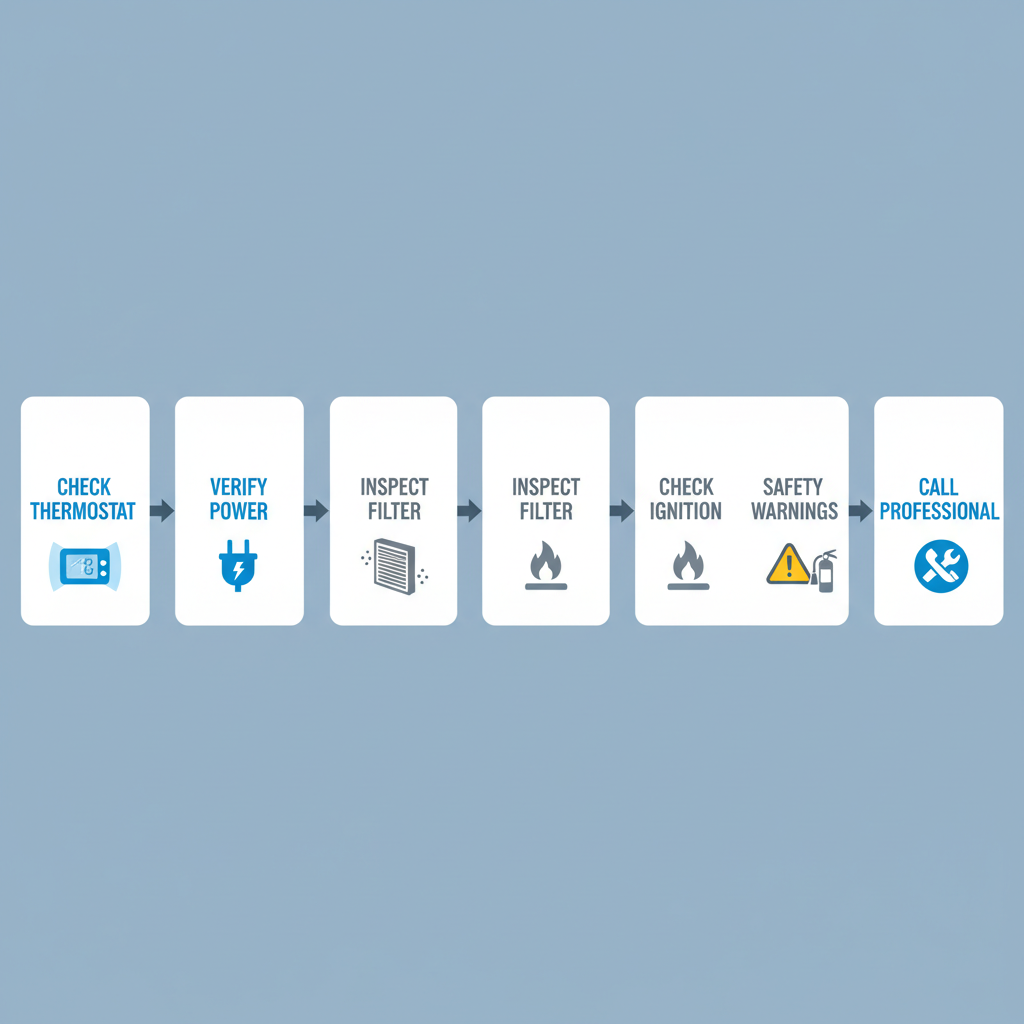
Homeowner troubleshooting guide for identifying and resolving common HVAC issues.
Cold Air Diagnosis
Specific cold air complaints trace directly to improper thermostat mode, extinguished pilot lights, dead igniters, or gas valve lockouts. Start by verifying heat mode on the thermostat, then visually confirm pilot or indicator status for gas units. Failure at this stage points to restricted airflow, blocked venting, or internal limit switch trips. Only a licensed professional should attempt repairs on these faults. Never ignore a persistent cold air issue, as it signals deeper system failure every time.
Call A Professional
Stop guessing and schedule a professional if you detect gas odor, multiple lockouts, carbon monoxide alarms, visible sparks, or if simple steps above fail. TruComfort technicians deliver rapid response for critical failures, honoring system warranties and safeguarding your household. DIY experiments cost more in the long run--call when safety, warranty, or diagnosis leaves any doubt.
DIY vs Professional Service Table
Task Homeowner Safe? Why Call Pro If| Replace Filter | Yes | Simple, reduces airflow restriction | Filter doesn't improve performance |
| Reset Breaker | Yes | Restores power to system | Breaker trips again |
| Ignition Repair | No | Gas and flame risk | Pilot won't light/flame unstable |
Advanced Causes And Prevention
Electrical And Fuel Issues
Lockouts caused by circuit board failures, transformer faults, or broken gas valves only masquerade as simple fixes. Electric heater faults involve breakers, wiring, or failed heating elements--unsafe for homeowner access. Gas line issues, valve failures, or regulator blockages never resolve without a professional. The fastest path to restored heat always involves bypassing do-it-yourself overreach and scheduling a licensed repair.
Carbon Monoxide Actions
Carbon monoxide remains the most severe heating system risk--silent and fatal. Symptoms include headaches, nausea, confusion, and fatigue. CDC guidance demands evacuation and immediate emergency service if a CO alarm sounds or any symptoms appear. Never re-enter until authorized. Working CO detectors and regular professional maintenance form the single proven shield against these tragedies in Connecticut homes.
Maintenance Plan Benefits
Annual maintenance proves itself by catching minor issues--dirty filters, loose wires, weak igniters--long before they become outages. TruComfort's Comfort Care Maintenance Plans provide prioritized repairs, systematic inspections, and substantial repair discounts. Customers protected by these plans report fewer breakdowns, longer system life, and sharply reduced emergency repair costs. A year-long plan outperforms any last-minute scramble.
Maintenance Plans Comparison Table
Plan Feature Basic Plan Comprehensive Plan| Annual Inspection | Included | Included with priority |
| Priority Service | No | Yes |
| Discounted Repairs | Limited | Higher discounts |
Common Homeowner Questions
Why Is My Heater Not Working?
The overwhelming majority of heat loss complaints originate with the thermostat, power supply, air filter, ignition or fuel issues--see troubleshooting above for a stepwise approach. Problems rarely arise from major equipment failure.
How To Troubleshoot Safely
Homeowners can only safely check thermostat settings, reset breakers, inspect and replace filters, and confirm the system display/pilot status. Any sign of sparking, gas smell, or CO alert--stop. Repairs involving wiring, gas, or panels belong exclusively to licensed professionals.
When To Call An HVAC Tech
If you experience gas odor, repeated lockouts, electrical sparking, or persistent cold air after the above checklist--call a professional immediately. Warranty protection, safety, and correct diagnosis demand professional intervention every time a system moves beyond basic homeowner checks.
Next Safety Steps
Immediate Actions
Follow each troubleshooting step in sequence if you lose heat. Evacuate at once on any suspicion of gas or carbon monoxide. Do not attempt restarts or guess at repairs involving power or fuel. If initial steps do not restore heat, schedule No Heat Repair service to avoid serious property risks as temperatures drop.
Scheduling Service
Professional intervention secures your warranty, restores system operation quickly, and delivers peace of mind. Expect clear communication and transparent pricing when you schedule heating service or emergency repair with TruComfort. Maintenance plan holders receive priority and faster problem resolution--another reason reactionary repairs will never match deliberate prevention.
Resources
We welcome your comments!
Our Mission
Our mission is to provide reliable, energy-efficient heating and cooling solutions that ensure the comfort and safety of our customers. We are committed to delivering exceptional service with integrity, innovation, and a focus on quality workmanship. Our goal is to build long-lasting relationships with our customers by exceeding their expectations and enhancing the comfort of their homes all while maintaining a commitment to sustainability and community responsibility.
Our Value
We are dedicated to delivering exceptional service through honesty, integrity, and professionalism. Our values center on quality craftsmanship, customer satisfaction, and continuous improvement. We prioritize safety, reliability, and respect in every interaction, ensuring that every customer feels valued and every job is completed to the highest standards. We embrace innovation and sustainability, striving to provide energy-efficient solutions that enhance comfort and reduce environmental impact. Our team is committed to fostering trust and building lasting relationships with our customers and community.
Comfort Care Maintenance Plans
Protect your HVAC investment and enjoy peace of mind with our Comfort Care Maintenance Plans. We offer a plan for every budget and situation, designed to keep your system running at peak performance year-round. Regular maintenance not only extends the life of your equipment but also improves energy efficiency and prevents unexpected breakdowns.
Elite Plan
Full system cleaning added benefits, including priority service and discounts on repairs.
Essential Plan
Ideal for basic, routine check to keep your system running smoothly.
Elite Winter Plan
Tailored maintenance focused on your heating system to ensure warmth and reliability through the colder months.
Elite Summer Plan
Specialized maintenance for your cooling system to keep you cool and comfortable during the hottest months.
